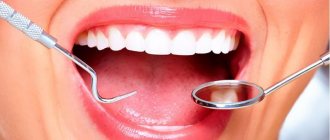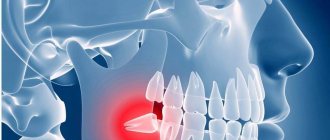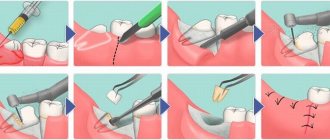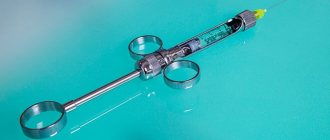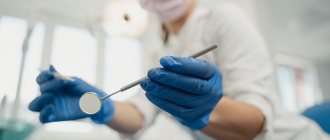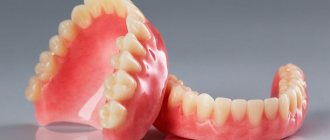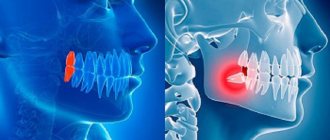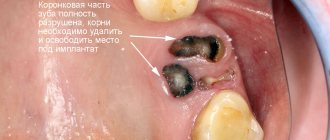Indications for removal
The dentist decides whether or not to remove a tooth, adequately assessing the situation in the mouth.
Direct indications are:
- advanced caries that cannot be treated;
- lack of a crown, with roots not suitable for implantation;
- crown fracture exposing the pulp;
- the dental unit is a source of infection, as a result of which complications develop (tonsillitis, periostitis, sinusitis, osteomyelitis of the jaw, abscess and phlegmon of the cheek);
- unsuccessful treatment of periodontitis;
- unerupted or incompletely erupted teeth are the cause of frequent inflammation, damage to nearby tissues and teeth;
- severe mobility with an extreme degree of periodontal damage that cannot be treated;
- purulent periodontitis, which is not relieved by conservative methods;
- crowding of teeth.
Recovery period
How long does recovery take after removal of upper wisdom teeth and what limitations does it impose? In most cases, after 1-2 days the patient returns to normal life, but sometimes recovery takes longer. To prevent the rehabilitation period from being prolonged, it is very important to follow the doctor’s recommendations:
- take prescribed antibiotics, painkillers and anti-inflammatory drugs;
- do not visit the bathhouse, sauna, swimming pool, or take a bath;
- follow a diet, if possible, eat only soft foods;
- refrain from smoking.
If the doctor did not make mistakes during removal, and the patient carefully followed all the doctor’s recommendations, then the recovery period will pass quickly, and the problem of the upper “eights” can be forgotten forever.
Contraindications
- acute diseases of the cardiovascular system;
- high blood pressure numbers;
- infectious processes in the body;
- menstruation period in women, since blood clotting time is increased, which threatens bleeding after extraction;
- acute, severe diseases of the central nervous system;
- pregnancy, lactation period;
- purulent-septic processes in the oral cavity, which provokes sepsis; mental disorders.
The possibility of extracting a diseased tooth appears after treatment of these pathologies and stabilization of the patient’s condition. In case of an emergency, the doctor performs removal in a patient with concomitant diseases. Severe pain syndrome is the cause of exacerbation of chronic pathology.
A planned operation to remove lower teeth is performed:
- When dental tissues are destroyed below the gum level. Such a dental unit cannot be used as a support for orthopedic treatment.
- Impenetrable root canals. In this case, conservative treatment becomes impossible.
- Tooth mobility in all planes.
- If, in the case of a jaw bone fracture, a dental unit is found in the fracture line. In this case, without removing the tooth, it is not possible to correctly compare the fragments.
- Dystopian teeth.
- "Eights" covered with a hood of mucous membrane. With frequent exacerbation of pericoronoritis.
Contraindications
Like any dental procedure, extraction surgery sometimes requires a delay. When is this operation contraindicated?
Local contraindications:
- Inflammatory diseases of the soft tissues of the oral cavity (stomatitis, gingivitis, etc.).
- If the dental unit is in the projection of a malignant tumor.
- Damage to the mucous membrane caused by an allergic response (medicinal stomatitis, cheilitis, etc.).
- Manifestation of specific infections in the oral cavity: tuberculosis, syphilis, actinomycosis.
- Radiation therapy or radiation sickness.
- If there is no permanent tooth germ in the jawbone, then removing the temporary unit should be delayed as long as possible.
General contraindications:
- Diseases of the heart and blood vessels.
- Chronic diseases of internal organs in the acute stage.
- Acute degree of mental disorder.
- Infectious disease: measles, chickenpox, scarlet fever, diphtheria, dysentery, influenza.
- Pathology of the nervous system.
- Blood diseases.
- The beginning of pregnancy and the last trimester of pregnancy.
Removal techniques
The dental surgeon determines the extraction tactics individually for each patient. Takes into account the location of the tooth, the type of pathological process, and the degree of spread. Before extraction, the doctor sends the patient for an x-ray. The goal is to obtain accurate information about the roots and structural features of adjacent teeth and the jaw apparatus in which the pathological unit is located.
Simple operation
In the case of a conventional location, removal occurs in a simple way, which takes no more than 10 minutes, taking into account the effect of anesthesia. The dental surgeon performs the operation according to the following scheme:
- a preliminary survey of the patient about allergies to anesthesia drugs, chronic pathologies and the medications he uses;
- administration of a drug for superficial sedation in order to normalize the mental state and ensure a comfortable extraction process (at the request of the patient or according to indications);
- injection of a local anesthetic into nearby tooth tissues (gums, cheek), usually using ultracaine, which is considered hypoallergenic;
- after 4-5 minutes, the surgeon begins the removal process by loosening the tooth in the surrounding tissues;
- after ensuring mobility, the specialist separates the tooth from the gum and with a sharp movement turns it out of the alveolar socket;
- the wound is treated with an antiseptic solution;
- a tampon with a medicinal substance is applied to the wound, after which the bleeding stops for several minutes;
- if after tooth extraction the wound surface is too large, the doctor will apply several stitches, which will prevent the possibility of postoperative infection and bleeding in the future;
- the patient receives recommendations and goes home after stabilizing his physical and emotional condition.
After removal using a simple method, the patient feels well. If the wound bothers you after the anesthesia wears off, it can be easily eliminated by following your doctor's recommendations.
The hard way
When the doctor sees abnormalities on the x-ray, removal will be carried out in a complex way. The experience and skill of the doctor matters.
Stages in complex removal:
- taking anamnesis;
- choice of anesthesia;
- mandatory administration of sedatives to relieve tension in the patient;
- injection of local anesthesia into 5-6 areas surrounding the tooth to be removed;
- the doctor makes an incision in the gum to access the tooth and roots;
- drilling into several parts using a drill for easy removal and prevention of injury;
- the tooth is separated from the gum in parts and removed;
- a mandatory revision of the resulting hole is performed;
- the wound is treated with an antiseptic and sutured;
- To prevent infection and bleeding, the doctor places a drug or PRP membrane in the wound. They dissolve along with the sutures.
Extraction during the normal course of the process takes 20-30 minutes. If the operation is complicated, the procedure may take up to 2 hours. After a complex removal, the wound is wider, the tissue is more traumatized, the pain is more pronounced and lasts longer.
It is important that removal is carried out carefully, taking into account future implantation. Therefore, it is better to entrust the operation to an experienced maxillofacial surgeon who will not damage the alveolar ridge. In this case, you will not have to build up bone tissue before installing the implant and eliminate possible complications. Average surgeons usually do not stand on ceremony during operations. The result is broken bone structures of the jaw, wandering remnants of roots, unremoved cysts growing into the maxillary sinus, perforations, fistulas, osteomyelitis and much more. Not to mention the shocking post-operative pain that overtakes the patient after such punitive surgery. Only the maxillofacial surgeon has enough theoretical and practical skills to perform tooth extraction without complications.
Why you shouldn’t refuse tooth extraction
Our reluctance to part with healthy teeth is legitimate and understandable. But an orthodontist drawing up a treatment plan cannot be guided solely by the patient’s wishes. The doctor focuses on the goal set for him and uses optimal methods that correspond to the real state of affairs to achieve it.
The need for removal is always carefully considered, because treatment with removal takes a lot of time, and for the dentist it also results in a larger amount of work and much greater responsibility. It is also necessary to understand that to make a decision on removal, the doctor does not need only a TRG image (teleradiogram). A treatment plan will be drawn up after obtaining a clear understanding of the patient's jaw anatomy to ensure that their facial contours are maintained after realignment.
Price
The cost depends on the technology used:
| Name of service | Price |
| Easy removal | 13,500 rub. |
| Difficult removal | 23,000 rub. |
The case includes:
- anesthesia;
- operation;
- removal and application of sutures.
Additional services:
| Name of service | Price |
| Sedation (per hour) | 12,000 rub. |
| Consultation with existing x-ray examination | 2,000 rub. |
| Consultation and X-ray diagnostics (CT scan in our Center on disk) | 5,200 rub. |
| Sight shot | 500 rub. |
How much does tooth root removal cost in Moscow?
The cost of tooth root removal is determined individually, as it depends on how complex the case is. In the dental department of the multidisciplinary clinic CELT, it starts from 800 rubles for a simple removal and ends at 10,000 rubles for a complex removal of a 2nd degree dystopic tooth. You can view our basic prices in this section of our website. In order to find out the exact cost of tooth root removal in our clinic in Moscow, consult our specialist.
In the dentistry of the CELT clinic, you can get a consultation with a dental surgeon, undergo an examination and remove the roots of the teeth, if there are indications for this. We will eliminate any dental problems effectively and absolutely safely.
Recommendations after surgery
- Do not eat or drink water for 6-7 hours after surgery;
- reduce physical activity, avoid visiting saunas and swimming pools for 4-5 weeks to prevent the development of bleeding;
- take analgesics to relieve pain in the early period;
- regularly take antibiotics prescribed for a course of 7 days;
- rinse your mouth with an antiseptic solution after eating;
- follow a gentle diet, avoid solid and irritating foods;
- stop smoking - nicotine provokes bleeding.
Following the doctor's recommendations reduces wound healing time and prevents the development of complications.
Is it painful to remove an upper wisdom tooth?
Based on patient reviews, we can conclude that what scares them most about the operation of removing the upper “eights” is pain. But you shouldn’t be afraid of it: modern anesthetics completely block unpleasant sensations. Even if one of the drugs did not provide high-quality pain relief, the doctor will always be able to choose another one. There is no need to endure pain during wisdom teeth removal!
Most often, patients complain of pain not during, but after surgery. This is quite predictable: the anesthesia wears off and the body “remembers” the wound in the mouth. To relieve pain during the rehabilitation period, the doctor prescribes painkillers to the patient. With a simple removal of a wisdom tooth from above, 1-2 appointments may be enough, but after a complex operation, you will have to take pills for several days.
How long does it take for a wound to heal?
Normally, the wound surface heals in 4-5 weeks. In older patients, healing is delayed due to decreased tissue repair and reduced blood circulation.
The rate of healing depends on the extent of the procedure and the roots. In the case of complex removal of a molar with 3-4 roots, the process of tissue regeneration is delayed up to 20-25 days.
Restoration of gum tissue goes through the following stages:
- in the first days, the wound is closed by a blood clot (thrombus), formed as a result of stopping the bleeding;
- 3-4 days after removal, the thrombus resolves, and new tissue appears on the surface of the wound in the form of a thin film;
- bone tissue forms on the sides of the socket already at 3 weeks;
- after 3-6 months, the hole heals and has no differences with the jaw bone.
The speed of wound healing after removal depends on the characteristics of the body and the age of the patient. If necessary, the doctor corrects the tissue regeneration process with medications and physiotherapeutic methods.
Possible complications
The structural features of wisdom teeth determine the possibility of surgical and postoperative complications - this is another reason for patients to be concerned about the removal of wisdom teeth. Fortunately, they are quite rare and in most cases are associated with insufficient professionalism of the doctor. If the surgeon acts carefully, then unpleasant consequences can be avoided. However, it is worth knowing what you might encounter.
- Tooth destruction during the extraction process.
This can happen if the integrity of the enamel is damaged by caries, and the doctor presses too hard on the forceps. It is accompanied by a characteristic cracking sound and can greatly frighten the patient. Requires careful removal of fragments from the hole. - Fracture of the jaw bone.
This is also a consequence of the rough work of the surgeon, who, by applying forceps, can capture part of the alveolar process along with the tooth. - Alveolitis.
This is inflammation of the socket, accompanied by swelling, pain, fever and bad breath. Requires immediate sanitation of the wound surface and antibiotics. - Damage to the maxillary sinus.
A rare but very dangerous complication when perforation of the wall of the maxillary sinus occurs. To avoid this, the doctor should carefully study the x-ray and act as carefully as possible.


